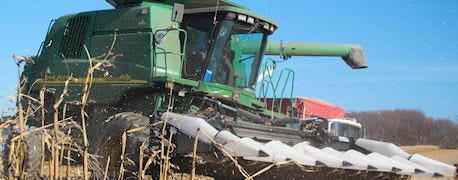
An abundant corn and soybean harvest is a good thing, unless you have no room to store the crops. That's why in early August, American Agriculturist found that "business is booming" for grain bin marketers. All sales persons contacted at Empire Farm Days and Ag Progress Days reported that their construction crews were booked solid well into this harvest.
So what do you do if lines are backed up at local mills and elevators? With 10% to 15% or more grain dry matter losses, holding off harvest isn't a good solution at current grain prices.

WHERE TO FROM HERE? With grain bins brimming with corn or soybeans and limited commercial storage, leaving corn in the field is a money-losing idea.
So what can you do? We scoured website resources for answers. Here are a few, gathered from Charles Hurburgh, ag and biosystems engineer at Iowa State University:
Temporary grain storage is meant to be just that – temporary – for less than 6 months. Existing building, such as pole barns, machinery sheds, warehouses or livestock buildings are preferred over outdoor piles. And, you still need to protect the grain from moisture, birds, rodents and insects.
An empty silo previously used for silage may be an option. But it must be structural sound, and hooped or reinforced sufficiently to store dry shelled grain. It must have a roof and a concrete floor.
Any storage system must be equipped with aeration. Even dry corn will spoil because of temperature-induced moisture migration, if aeration isn't used to balance grain and air temperatures. Figure about 1 h.p. of fan per 10,000 bushels, to maintain temperature (not drying).
A building to be used for storing grain must be well-drained. Whether it has a concrete floor or not, cover the floor with plastic to prevent moisture from migrating upward.
Your grain must be cool and dry to store at these sites. That may require aeration cooling.
For more about on-farm storage of grain and grain quality issues, visit the Iowa Grain Quality Initiative website: www.extension.iastate.edu/grain. Be sure to check out the structure specification considerations in Fact Sheet #38.
About the Author(s)
You May Also Like




